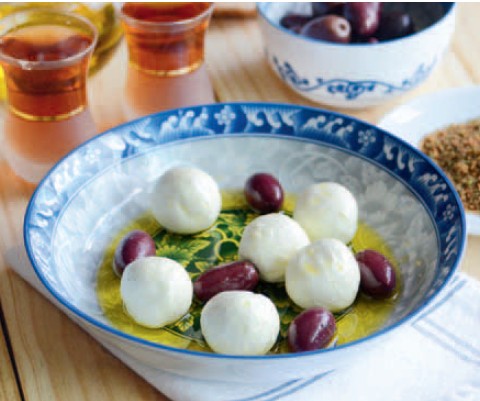CHAPTER FOUR
Appetizers and Light Meals
These dishes are the tasty morsels that are frequently thought of as maza, which is basically the equivalent of tapas in Spain. (For more information on maza, see Putting Together Maza Platters, page 14.) It's quite common to group a few of these dishes together (along with maybe a salad and one or two vegetable dishes) for a full meal, especially if you’re cooking for just yourself or yourself plus one or two others; however, these dishes can also be served as appetizers before a larger meal. A few of the recipes in this section (the dips in particular) are perfect for using up leftovers; Garlicky Potato Dip (Mutabbal Batata)(page 67) is a delicious use for leftover potato, and both Zucchini Dip (Mutabbal Kousa)(page 64) and Zucchini Fritters (Ejet Kousa) (page 65) are wonderful for using up leftover zucchini.
MUTABBAL BATINJAN
Mutabbal Batinjan, a delicious, creamy eggplant dip with tahini and yogurt, is commonly mistaken for another eggplant-based dip called Baba Ghanouj. Baba Ghanouj doesn’t have tahini or yogurt, but instead has a plethora of fresh veggies mixed in, like green bell pepper, tomato, green onion (scallion), and parsley; lemon, garlic, and occasionally walnuts and pomegranate molasses are also added to Baba Ghanouj.
Serves 8
Preparation Time: 20 minutes
Cooking Time: 40 minutes
1 medium globe eggplant (1-1¼ lb/500-600 g)
3 cloves garlic, crushed
1 teaspoon salt
½ cup (125 g) tahini
4 tablespoons fresh lemon juice
4 tablespoons plain yogurt
1 tablespoon thinly sliced walnuts (optional)
Salt, to taste
3 tablespoons olive oil
1 tablespoon minced fresh parsley leaves (optional, for garnish)
Flatbread (for serving)
1 Preheat the oven to 400˚ F (200˚ C). Pierce the eggplant
a few times with a sharp knife, transfer to a sheet pan, and roast until soft, about 40 minutes. (Alternatively, the whole eggplant can be grilled until tender.) when it’s cool enough to handle, cut the eggplant in half lengthwise, scoop out the flesh, and chop it.
2 Mash the eggplant, garlic, salt, tahini, lemon juice, and yogurt together in a large mortar and pestle until it reaches your desired consistency, (it can be completely smooth or you can leave a few lumps for texture; alternatively, this can be done in a food processor). Stir in the walnuts, if using, then taste and add more salt as desired.
3 transfer to a large, shallow serving dish and drizzle olive oil on top; sprinkle on the parsley, if using.
4 Serve with flatbread to scoop up the dip.
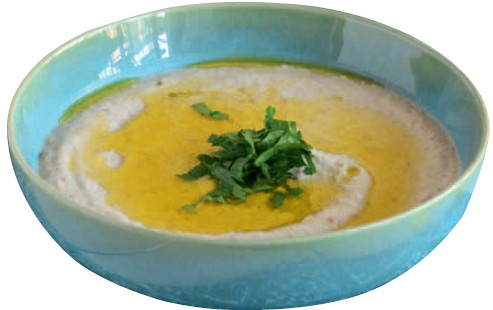
VARIATION
This variation is the perfect use for the marrow squash or zucchini insides after you’ve made Stuffed Marrow Squash (page 107).
Serves 4
Preparation Time: 10 minutes
Cooking Time: 15 minutes
Insides from 2 lb (1 kg) marrow squash or zucchini washed and peeled
2 cloves garlic, crushed
1 teaspoon salt
3 tablespoons plain yogurt
2 tablespoons fresh lemon juice
2 tablespoons olive oil
Fresh parsley or mint leaves (optional, for garnish)
Flatbread (for serving)
1 Place the zucchini/marrow squash in a medium, thick-bottomed saucepan over moderately high heat. Cook (uncovered) until it’s soft and the liquid is evaporated, about 15 minutes, stirring frequently; cool.
2 Mash the zucchini/marrow squash, garlic, salt, yogurt, and lemon juice together in a large mortar and pestle until it reaches your desired consistency, (it can be completely smooth or you can leave a few lumps for texture; alternatively, this can be done in a food processor).
3 transfer to a serving dish, drizzle on the olive oil, and top with fresh parsley or mint leaves, if using.
4 Serve with flatbread to scoop up the dip.
EJET KOUSA
Whenever my husband and I visit the Middle East and stay with his family, any morning we wake up to one of my mother-in-law’s egg dishes we know it will be a good day. These fritters are basically savory pancakes; they’re scented with garlic and onion and a stack of them is all it takes to bring a smile to my face in the morning. They’re great served hot, warm, or room temperature, and I like them with olives, fresh tomatoes, and a stack of flatbread.
Serves 4 as a part of a maza platter or 2 as a meal
Preparation Time: 10 minutes
Cooking Time: 20 minutes
2 tablespoons olive oil
1 onion, diced
¾ lb (350 g) zucchini (about 1 medium), grated
2 large cloves garlic, crushed in a mortar and pestle with 1 teaspoon salt
4 large eggs
4 tablespoons all-purpose flour
½ bunch fresh parsley, minced
Pinch of freshly ground black pepper
Canola oil, for frying
1 heat the olive oil in a medium skillet over medium heat; add the onion and cook until it starts to soften, about 5 minutes, stirring occasionally. Add the zucchini and cook until softened and the water has evaporated, about 8 minutes, stirring occasionally; add the garlic and cook 1 minute more, stirring constantly. Cool slightly.
2 Lightly beat together the eggs, flour, parsley, and black pepper in a medium bowl. Stir in the zucchini mixture.
3 Add enough canola oil to a large nonstick skillet to lightly coat the bottom; heat the oil over medium heat.
4 Drop the batter into the hot pan using a small (about 2 tablespoon) or large (about 4 tablespoon) scoop. Fry until set and golden on one side, about 2 minutes; flip and cook until set and golden on the other side, about 1 minute.
5 transfer the cooked fritters to a paper towel-lined plate to drain any excess oil, and cook the remaining egg mixture the same way, adding more oil to the skillet as necessary.
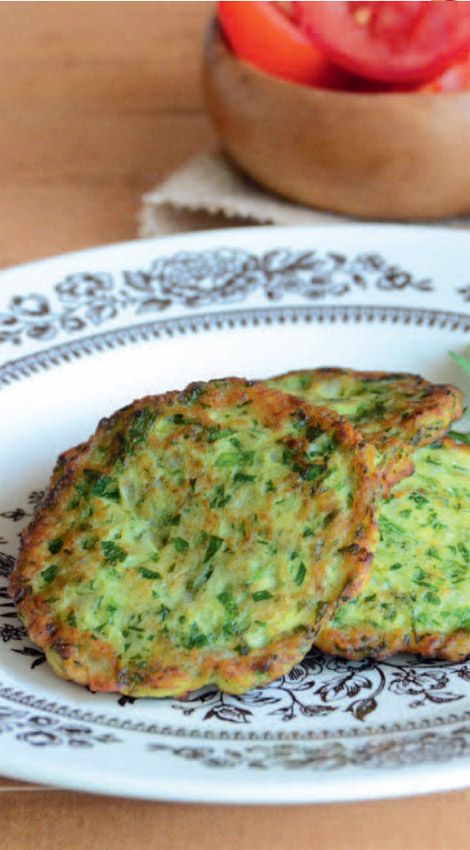
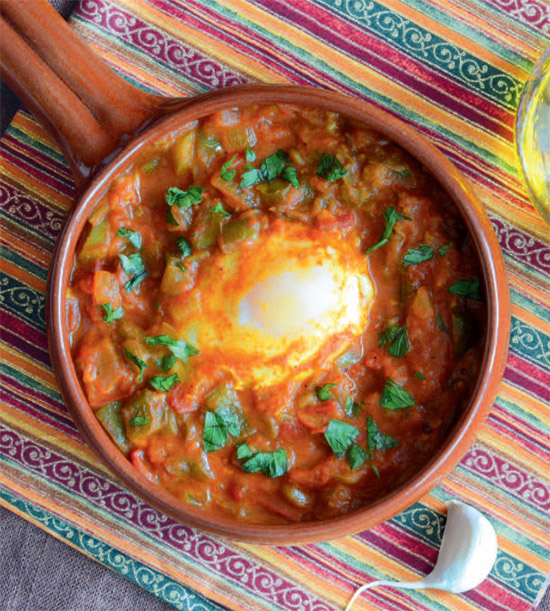
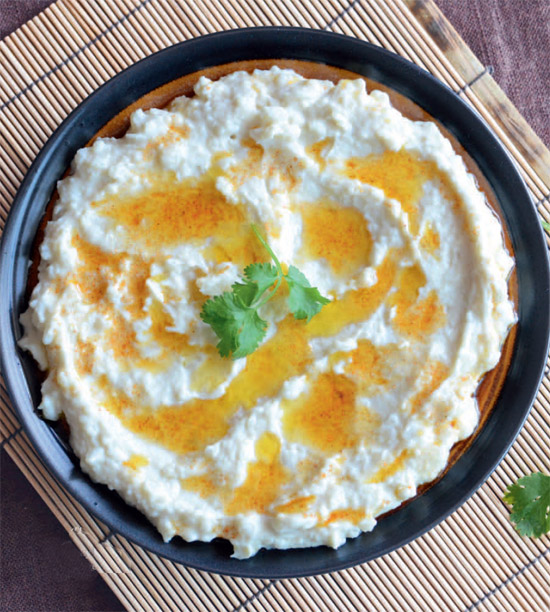
Eggs Poached in Spicy Tomato Sauce JUZMUZ
There are different versions of this dish all across the Middle East; this is the Syrian version, taught to me by my mother-in-law, which I think is particularly delicious. The sauce is a great balance of sweet, heat, and spicy flavors. The best way to eat this dish is to break open the egg yolk and then eat with flatbread.
Serves 4 as part of a maza platter or 2 as a meal
Preparation Time: 15 minutes
Cooking Time: 25 minutes
2 tablespoons olive oil
1 green bell pepper, deseeded and diced
1 small onion, diced
1 small hot green chili pepper, minced
2 cloves garlic, crushed
½ teaspoon salt
2 tomatoes, diced
1 teaspoon ground cumin
½ teaspoon ground turmeric
½ teaspoon ground paprika
¼ teaspoon ground red pepper (cayenne)
1/8 teaspoon freshly ground black pepper
1 tablespoon tomato paste
½ cup (125 ml) water
4 large eggs
1 sprig fresh parsley, chopped (optional, for garnish)
1 heat the oil in a medium lidded skillet over medium heat; add the bell pepper and onion and cook until softened, about 5 to 7 minutes, stirring occasionally.
2 Add the chili pepper, garlic, salt, and tomato, and cook
2 minutes; stir in the cumin, turmeric, ground sweet paprika, ground red pepper, and black pepper. Cook 1 minute more.
3 Add the tomato paste and water and bring up to a boil; cover the skillet, turn the heat down to simmer, and cook 10 minutes, stirring occasionally (during the last minute, remove the lid so the sauce can thicken and stir constantly).
4 use the back of a spoon to make 4 wells in the sauce, and then crack 1 egg into each well. Cover the skillet and cook until the egg whites are set and the yolks are cooked to your desired doneness (about 5 minutes will produce set whites with runny yolks).
5 Sprinkle on the parsley, if using; serve immediately.
Garlicky Potato Dip
MUTABBAL BATATA
In the Middle East, anything and everything you can think of is turned into dip, from avocado to beans, cheese, and zucchini. Many of these dip recipes were created to use up leftovers, but whether or not you have leftover potato, this dip is definitely worth making.
Serves 8
Preparation Time: 5 minutes, plus 20 minutes for the potatoes to cool
Cooking Time: 35 minutes
2 potatoes (about 1 lb/500 g), washed
2 cloves garlic, crushed
¾ cup (185 ml) plain yogurt
4 tablespoons tahini
1 tablespoon fresh lemon juice
½ teaspoon salt
1 tablespoon olive oil
Pinch ground red pepper (cayenne)
Fresh coriander leaves (cilantro) (optional, for garnish)

1 Put the potatoes in a medium saucepan and add enough water to cover them by 1 inch (2.5 cm). Bring up to a boil over high heat, then turn heat down to medium and cook until a paring knife slides right out when inserted fully into the middle of the potato, about 30 minutes.
2 Cool 20 minutes, then peel the potatoes and transfer the flesh to a medium bowl; coarsely mash with a fork.
3 Add the garlic, salt, yogurt, tahini, lemon juice, and salt to the potatoes; stir with a fork to combine, being careful not to over-mix. Combine the olive oil and ground red pepper in a small bowl.
4 transfer the dip to a serving bowl and drizzle the olive oil/ground red pepper mixture on top; garnish with fresh coriander leaves, if using.
These omelets are loaded with fresh herbs, for a bright, fresh flavor.
Serves 4 as part of a maza platter or 2 as a meal
Preparation Time: 10 minutes
Cooking Time: 10 minutes
4 large eggs
2 tablespoons all-purpose flour
¼ teaspoon salt
1/8 teaspoon freshly ground black pepper
½ bunch fresh parsley, minced
2 green onions (scallions), white and green parts, thinly sliced
2 sprigs fresh mint, stems discarded and leaves chopped
Oil, for frying
1 Lightly beat together the eggs, flour, salt, pepper, parsley, green onions, and mint in a medium bowl.
2 Add enough oil to a small nonstick skillet to lightly coat the bottom; heat the oil over medium heat.
3 Pour ¼ cup (65 ml) of the egg mixture into the hot oil and rotate the pan to spread it out. Fry until set on one side, about 1 to 2 minutes; flip and cook until set on the other side, about 30 seconds to 1 minute.
4 Remove the omelet, and cook the remaining egg mixture the same way, adding more oil to the skillet as necessary (you will end up with 4 omelets).
5 Serve warm.

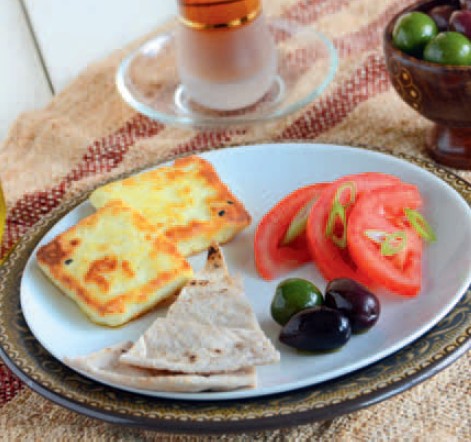
Pan-Seared White Cheese
JIBNEH MEKLEH
The first time I had cheese prepared like this was at a restaurant in Amman. It was part of a maza platter and my husband ordered sweet tea to pair with the salty cheese.
Serves 4
Preparation Time: 2 minutes, plus 2 to 4 hours to soak the cheese
Cooking Time: 5 minutes
Two thick slices (6 oz/175 g) Halloumi, Nabulsi, or Ackawi cheese, or fresh mozzarella sliced into ¼-½ in (6 mm-1.25 cm) thick slabs
1-2 tablespoons flour
1 tablespoon clarified butter (or ½ tablespoon unsalted butter plus ½ tablespoon canola oil)
Flatbread (for serving)
Olives and fresh tomato slices
1 to remove excess salt (if using halloumi, nabulsi, or Ackawi) soak the cheese in cold water for 2 to 4 hours (or overnight), changing the water several times; pat dry.
2 Coat the cheese with flour and gently rub off any excess.
3 Melt the clarified butter in a medium skillet over medium heat. Add the cheese and fry until golden brown on both sides, about 1 to 2 minutes per side.
4 Serve immediately, with flat bread and olives and/or tomato slices, if using.
SHANKLEESH
Traditionally, these cheese balls are left to ripen and mold for weeks (being periodically rinsed) before they are coated with spices and served, which takes a considerably longer time than my version.
Yields 10 servings
Preparation Time: 20 minutes, plus 3 days to drain the yogurt and let the balls refrigerate
Cooking Time: 5 minutes
4 lb (2 kg) plain yogurt
¾ teaspoon salt
2 teaspoons dried oregano
1 teaspoon ground sweet paprika
½ teaspoon ground red pepper (cayenne)
¼ teaspoon freshly ground black pepper
1 tablespoon Thyme Spice Mix (page 29) (for coating)
½ tablespoon ground sweet paprika and ½ tablespoon ground red pepper (cayenne) (for coating)
1 Prepare thyme Spice Mix.
2 Put the yogurt in a medium, heavy-bottomed saucepan over medium heat; cook (without stirring) until the curds and whey separate, about 5 minutes. Cool to room temperature.
3 Place a fine mesh sieve inside a bowl and place 2 pieces of cheesecloth or 3 coffee liners inside the sieve so that they drape over the sides. Pour in the yogurt and wrap the cheesecloth or coffee liners up over the top of the yogurt.
4 Cover the top with plastic wrap, place a heavy bowl or other object on top (to help it drain faster), and let it drain like this in the fridge for 2 days, pouring out the whey that collects in the bowl as necessary.
5 Combine the drained yogurt curds with the salt, oregano, paprika, cayenne, and black pepper in a medium bowl. Shape this mixture into 2 equal balls and transfer to a paper towel-lined tray and refrigerate 1 day, changing the paper towels once.
6 Roll 1 ball in thyme Spice Mix and the other ball in the paprika/cayenne mixture, then cover and store refrigerated until serving.
7 Serve with olive oil and flatbread, or make them into Spiced Cheese Ball Salad (page 47).
VARIATION
Farmer's Cheese Spiced Cheese Balls
For a fun and tasty version of this recipe that’s even faster, I use farmer’s cheese instead of yogurt, which eliminates the need to separate the curds from the whey. If you’re using Nabulsi or Ackawi cheese, do not add any salt; if you’re using fresh mozzarella, add salt to taste (about ½ to ¾ teaspoon).
¼ lb (100 g) Nabulsi, Ackawi, or fresh mozzarella cheese
¾ lb (350 g) farmer’s cheese
2 teaspoons dried oregano
1 teaspoon ground sweet paprika
½ teaspoon ground red pepper (cayenne)
¼ teaspoon freshly ground black pepper
1 tablespoon Thyme Spice Mix (page 29) (for coating)
½ tablespoon ground sweet paprika and ½ tablespoon ground red pepper (cayenne) (for coating)
1 If you’re using Nabulsi or Ackawi cheese, remove the saltiness by soaking the cheese in cold water for 2 to 4 hours (or overnight), changing the water several times; pat dry.
2 Finely crumble the Nabulsi or Ackawi with your fingers, or grate the mozzarella; combine it with the farmer’s cheese, oregano, paprika, cayenne, and black pepper in a medium bowl. Shape this mixture into 2 equal balls and transfer to a paper towel-lined tray and refrigerate 1 day, changing the paper towels once.
3 Roll 1 ball in thyme Spice Mix and the other ball in the paprika/cayenne mixture, then cover and store refrigerated until serving.
4 Serve with olive oil and flatbread, or make them into Spiced Cheese Ball Salad (page 47).
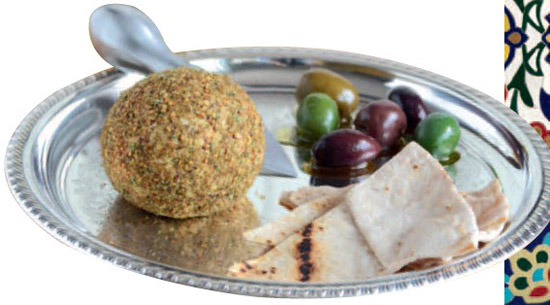
How to Stuff Grape Leaves

STEP 1: Place 2 to 3 teaspoons of filling across the leaf above the point where the stem was cut off.
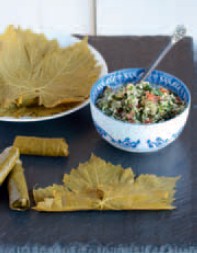
STEP 2: Fold bottom of the leaf up over the stuffing.

STEP 3: Fold over the sides of the leaf onto the stuffing.
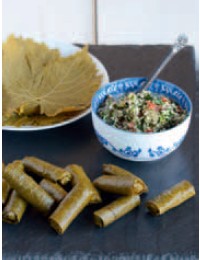
STEP 4: Roll up the leaf, tucking in the sides as you go.
Vegetarian Stuffed Grape Leaves WARAQ AL AINAB OR DAWALI
Grape leaves (or vine leaves) can be stuffed with either a vegetable or meat-based rice stuffing. This recipe is the vegetarian version, which is light and fresh, more like a salad than anything else. The version with meat is typically served hot as a main course (for the recipe, see Lamb and Rice Stuffing (Heshweh) on page 28); this vegetarian variation is usually served at room temperature, as part of a maza platter. (Note: when the stuffed grape leaves are cooked, a heavy, flat, disk-shaped object must be placed into the pot to weigh the leaves down and keep them submerged beneath the liquid. In Arabic, this tool is called a Teteelet Fakhar, but any heat-safe lid or plate that fits nicely into your pot will work.)
Serves 8 to 10
Preparation Time: 2 hours, plus 3 hours for the rice mixture to soak before stuffing the leaves and time for the stuffed grape leaves to cool before serving
Cooking Time: 1 hour, 45 minutes
1½ cups (325 g) uncooked medium-grain white rice, rinsed
3 tablespoons oil
1 onion, finely diced
2½ teaspoons salt, divided
2 tomatoes, finely diced
1 bunch fresh parsley, minced
6 tablespoons (90 ml) fresh lemon juice, divided
4 tablespoons olive oil, divided
4 tablespoons dried, crushed mint
One (1 lb/500 g) jar of brined grape leaves, rinsed (see Grape Leaves, page 20)
2 medium potatoes, peeled and sliced
Hot water, to cook the grape leaves
Plain yogurt (optional, for serving)
2 lemons, wedged (optional, for serving)
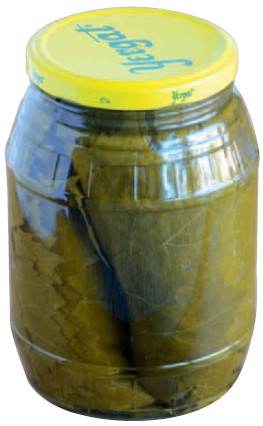
1 Soak the rice in tepid water for 10 minutes; drain.
2 heat the oil in a large skillet over medium heat; add the onion and 1 teaspoon salt, and sauté until the onion starts to soften, about 3 to 5 minutes. Cool completely.
3 Combine the onion, remaining 1¼ teaspoons salt, tomato, parsley, 3 tablespoons lemon juice, 2 tablespoons olive oil, mint, and rice in a large bowl; cover the bowl and refrigerate 3 hours.
4 Soak the grape leaves in hot water for 10 minutes, changing the water twice; drain. Trim off the stems, if necessary.
5 to stuff the grape leaves, lay 1 leaf flat on your work surface with the shiny side facing down. Place 2 to 3 teaspoons of filling (adjust the amount based on the size of your leaves) across the leaf above the point where the stem was cut off. Fold the bottom of the leaf up over the stuffing, and then fold over the sides of the leaf onto the stuffing. Roll up the leaf, tucking in the sides as you go. Continue this way until all the leaves are stuffed. (Note: if you have any leaves that are very small, you can place 2 leaves overlapping and stuff them.)
6 Line the bottom of a medium-large, thick-bottomed, lidded pot with the potato. Arrange the grape leaves (seam-side down) in compact rows on top of the potatoes, continuing with additional layers until all the grape leaves are in the pan.
7 Sprinkle the remaining 3 tablespoons
of lemon juice, remaining 2 tablespoons of olive oil, and remaining ¼ teaspoon salt on top of the leaves; place a heavy, flat, disc-shaped object (such as a heat-safe lid or plate) into the pan on top of the leaves. Add enough hot water to cover the leaves by 2 inches (5 cm).
8 Bring to a boil over high heat, then cover the pot, turn the heat down to low, and simmer until the rice is tender, about 1 hour, 15 minutes to 1 hour, 45 minutes; cool.
9 to serve, drain the stuffed grape leaves in a large colander, reserving the liquid in a bowl under the colander (store any leftovers in this liquid). Arrange on a platter and serve at room temperature, along with plain yogurt and lemon wedges, if using.
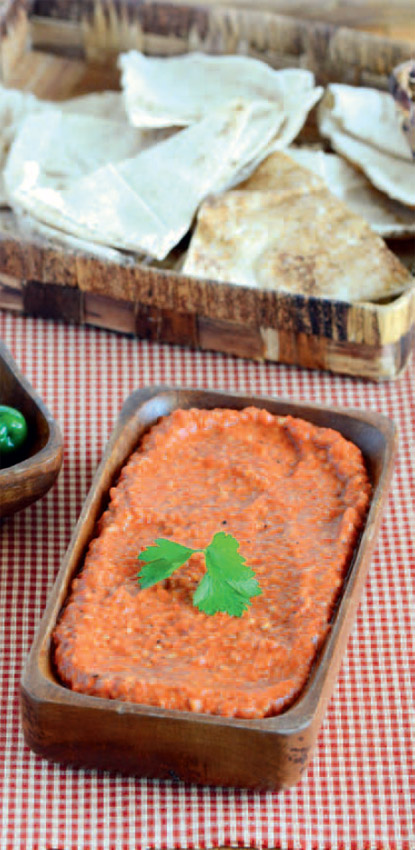
MUHAMMARA
Peppers grow in abundance in Aleppo, Syria, which is where this dish comes from. Walnuts, pomegranate molasses, and sumac are ingredients that make this dish rich and nutty, with a sweet/tart yet also savory and spicy flavor. In many dishes, whether or not the breadcrumbs are fresh really doesn’t make a big difference. This is not one of those dishes. Rather, this dip really benefits from taking the extra couple of minutes to make the breadcrumbs. To do so, tear a slightly stale piece of flatbread into large pieces; put it in the food processor and pulse until it forms breadcrumbs. Any extra breadcrumbs you have can be stored in zipper-top plastic bag in the freezer for up to 6 months. (note: the amount of breadcrumbs can be increased if you prefer a thicker dip.)
Serves 6 to 8
Preparation Time: 25 minutes
Cooking Time: 10 minutes
3 red bell peppers, halved and deseeded
2 tablespoons olive oil
½ cup (50 g) chopped walnuts
2 cloves garlic, peeled
1 small onion, chopped
1 tablespoon pomegranate molasses
¾ teaspoon salt
½ teaspoon ground red pepper (cayenne)
½ teaspoon ground cumin
½ teaspoon ground sumac
¼ teaspoon freshly ground black pepper
¼ cup (20 g) fresh bread crumbs
Fresh parsley or mint leaves (optional, for garnish)
1 Preheat the broiler. Put each pepper half skin-side-up on a flat surface and press down with your hand to flatten. Transfer to a baking sheet and broil until the skin is blackened and blistered (about 10 to 12 minutes). Immediately transfer the peppers to a bowl and cover (or to a large, zipper-top plastic bag) and let them sit 15 minutes. Peel off skin (do not rinse) and coarsely chop peppers; drain off any excess water.
2 Combine the bell pepper, olive oil, walnuts, garlic, onion, pomegranate molasses, salt, cayenne, cumin, sumac, and black pepper in the bowl of a food processor; pulse until it comes together as a chunky paste, scraping down the sides of the bowl as necessary. Pulse in the breadcrumbs. (Alternatively, this can be done by hand using a large mortar and pestle.)
3 transfer to a serving dish and garnish with fresh parsley or mint leaves, if using.
LABNEH
Yogurt Cheese is soft and creamy with a mild, tangy flavor. It can frequently be found spread inside sandwiches or as part of a maza platter for breakfast along with olives, fresh mint, flatbread, olive oil, thyme Spice Mix (page 29), and some sliced tomato, cucumber, and/or green onion. The best way to serve Yogurt Cheese is to spread it into a shallow bowl and top it with a generous douse of olive oil; anything you add to flavor it beyond that (such as dried mint or other spices) is up to you.
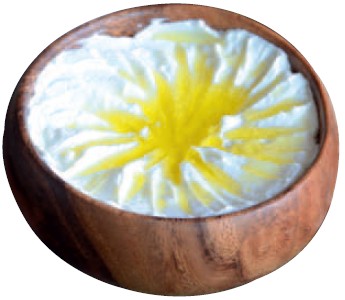
Yields 14 oz (400 g) of cheese and 2 cups (500 ml) of whey
Preparation Time: 5 minutes, plus 1 to 2 days to let the yogurt drain
2 lb (1 kg) plain yogurt
1 tablespoon olive oil (for serving)
A pinch of dried mint (optional, for serving)
1 Place a fine mesh sieve inside a bowl and place 2 pieces of cheesecloth or 3 coffee liners inside the sieve so that they drape over the sides. Pour in the yogurt and wrap the cheesecloth or coffee liners up over the top of the yogurt.
2 Cover the top with plastic wrap, place a heavy bowl or other object on top (to help it drain faster), and let it drain like this in the fridge for 1 to 2 days, pouring out the whey that collects in the bowl as necessary.
3 to serve, transfer to a shallow bowl, drizzle the olive oil on top, and sprinkle on the mint, if using.
VARIATION
Yogurt Cheese Balls in Oil
LABNEH M’DOWARA
Yields about 10 to 12 cheese balls
Preparation Time: 20 minutes, plus 6 days to drain the yogurt and let the balls refrigerate
2 lb (1 kg) plain yogurt
2 teaspoons salt
Enough olive oil to cover the cheese balls (about 1¼ cups/300 ml total)
4-5 olives to garnish when serving
1 Combine the yogurt and salt in a medium bowl. Line another medium bowl with 2 pieces of cheesecloth; pour the yogurt onto the cheesecloth and tie the ends of the cheesecloth together (or tie it closed with string). Tie the cheesecloth to a long spoon and lay the spoon across the top of a deep bowl or pot (making sure that the cheesecloth doesn’t touch the bottom). Let it drain like this for 4 days in the fridge, pouring out the whey that collects in the bottom each day.
2 Roll the strained yogurt into balls about 1½ tablespoons each. Transfer to a paper towel-lined tray and refrigerate 1 day, changing the paper towels once.
3 Sterilize a 1-pint (500 ml) canning jar; transfer the balls to the sterilized jar and add oil (half olive and half canola) to cover; refrigerate 1 day before eating. Store refrigerated.
